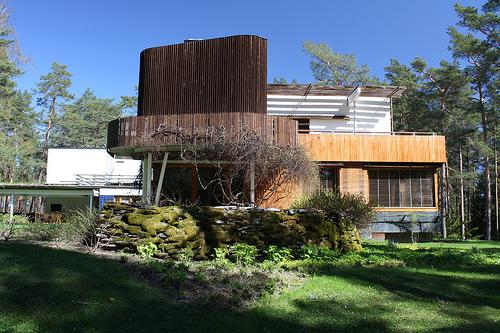
Although Alvar Aalto first won worldwide attention in the early 1930s as a leading exponent of the International Style—a reductive form of modern architecture proposed as equally applicable anywhere on the planet—his more expressive, site-specific work from the mid-Thirties onward marked him as a regional designer in the best sense, and the quintessential Finnish master builder. In 1989, however, thirteen years after Aalto’s death, his friend and official biographer Göran Schildt revealed Aalto’s rollicking 1943 junket to Germany at the invitation of Albert Speer, Hitler’s court architect-turned-munitions chief, to inspect construction there just as the Final Solution shifted into overdrive. Schildt’s tragicomic account reads like a plot outline for The Three Stooges Go to Hell.
Thus, it is startling that Eeva-Liisa Pelkonen chooses to omit that episode in Alvar Aalto: Architecture, Modernity, and Geopolitics, particularly in view of her publisher’s claim that the new book offers a “dramatically different interpretation” of Aalto’s central part in defining Finland’s international reputation during the Cold War—or, more to the point, after his homeland sided with Germany against the Soviet Union during World War II.
Through an ingenious postwar public-relations campaign, the resourceful Finns—implicitly anti-Communist notwithstanding their official neutrality after 1945—exploited Aalto’s humane, organic version of high-style Modernist design (along with work by his like-minded though lesser compatriots) to dispel unpleasant memories of Finland’s Faustian bargain with Hitler, a misalliance apologists ascribed to age-old hatred of Russian oppression and rationalized by the truism “the enemy of my enemy is my friend.” (In fairness, Finland was attacked by Soviet troops in 1939 and hoped to use its alliance with Germany two years later to protect against further Soviet encroachment and regain the considerable territory it had lost.)

Indeed, apart from his reprehensible dalliance with Nazi Germany, Aalto’s humanism—exemplified by his love of warm, natural materials and move away from severe, mechanistic imagery—remains beyond question. By the time World War II began, Aalto had abandoned the International Style and developed a far more personal approach reflected in buildings responsive to their natural settings, exemplified by his Villa Mairea of 1937-1939 in Noormarkku, the interior of which connects with and evokes its surrounding landscape with remarkable immediacy yet an utter lack of representational kitsch.
Uneasy with the industrial connotations of tubular metal furniture designed during the Twenties by modernists including Marcel Breuer, Mart Stam, and Ludwig Mies van der Rohe, Aalto devised bent and molded plywood chairs, stools, and tables that are warm to the touch and less reflective of light and sound. Tellingly, many of those pieces are still in production after almost eighty years.
There is no evidence that Aalto harbored any Fascist sympathies either before or after that one major lapse. But because Pelkonen (a Yale architecture professor and co-editor of the catalog for the traveling Eero Saarinen retrospective now on view at the Yale University Art Gallery) purports to address twentieth-century geopolitics—an ambitiously broad topic—her fixation on Soviet-Finnish relations and her silence on Finland’s and Aalto’s wartime involvements with Germany fatally undermine her stated intention.
Furthermore, there is nothing novel in Pelkonen’s observation that Aalto’s work embodied the same patriotic values earlier expressed by the architecture of Finland’s National Romantic movement, a regional variant of Arts and Crafts “total design” that flourished at the turn of the twentieth century. Likewise, Aalto’s sensitivity to nature and responsiveness to the environment have been amply illuminated by many other scholars who have noted his subtle evocations of arctic terrain in schemes such as the Finnish Pavilion at the 1939 New York World’s Fair.
The architectural historian Barbara Miller Lane’s National Romanticism and Modern Architecture in Germany and the Scandinavian Countries (2000) placed Aalto firmly within the broader setting of culture and détente that Pelkonen promises but fails to fully elucidate. Lane’s pioneering research into the architecture of the Third Reich—epitomized by her classic 1968 study Architecture and Politics in Germany, 1918-1945—helped legitimize that long-taboo topic by confronting stark realities this new book ignores. Despite the Finnish-born Pelkonen’s linguistic advantage in dealing with Aalto, she seems subject to the same willful amnesia that still enshrouds this dark chapter in their country’s history.
Eeva-Liisa Pelkonen, Alvar Aalto: Architecture, Modernity, and Geopolitics (Yale University Press, 2009)


